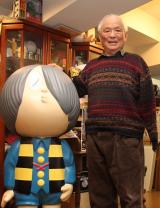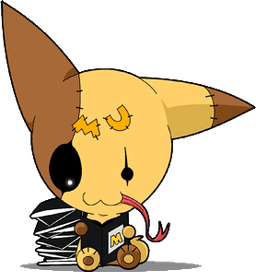
Shigeru Mizuki was a Japanese mangaka, specialized in the Japanese horror genre yōkai and World War II themes. He was born Shigeru Mura in Sakaiminato in Tottori prefecture, the basis for his career was layed during his childhood, when he picked up drawing and listened to local ghost stories. He studied fine arts in Musashino and was drafted into the Imperial Japanese Army during World War II. He served in Papua New Guinea, where he lost his left arm. Back in Japan, he worked as a movie operator until making his debut as a cartoonist in 1956.
He assumed the name Mizuki while managing an inn called Mizuki Manor. During this period, he also made pictures for picture story shows. Ever since his earliest works, such as 'Rocketman' (1957), Mizuki's stories were based on military and mythological themes. He also wrote several books on these subjects, as well as a manga biography about Adolf Hitler.
He gained most fame for his horror manga 'Gegege no Kitaro', or 'Hakaba no Kitaro' (Ghost Family), that drew inspiration from folklore creatures known as yōkai. This series about a little ghost appeared from 1965 to 1969 in Shônen Magazine, and has been turned into a new anime series every decade since 1968. Other 1960s serials include 'Kappa no Sanpei' and 'Akuma-kun' that were published in rental-library books and paper theatres, and have both also been turned into anime series. His most famous creation is 'Hakaba no Kitarô', or 'Ghost Family'.
He is also known for his World War II memoirs, such as his short work about the atrocities commited by the Japanese army titled 'War and Japan' for the educational magazine The Sixth Grader in 1991. A road was named in his honor in the Rabaul township in Papus New Guinea's East New Britain province, where he befriended the local Tolai tribespeople while a prisoner of war.
Shigeru Mizuki resided in Tokyo. He was largely responsible for keeping the yōkai tradition alive in Japan, and has won just about every award a mangaka or Japanese citizen can win and has been named to the Japanese Society of Cultural Anthropology. He won the Seiun Award for Best Artist in 1998.
He passed away on 30 November 2015, at the age of 93, due to heart attack.
Among his assistants at Mizuki Pro there were IKEGAMI Ryoichi, TATSUMI Yoshihiro, TSUGE Yoshiharu, SUZUKI Oji, MORINO Tatsuya, FURUKAWA Masuzou, NACHI Misako, TSURITA Kuniko, KITAGAWA Kazuyoshi, SASAOKA Kenji, HASHIMOTO Tasuku, TSUCHIYA Shingo, MURASAWA Masao, ISHIGURO Mikage, ITOU Masaki & KURE Tomofusa.




